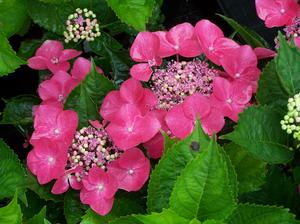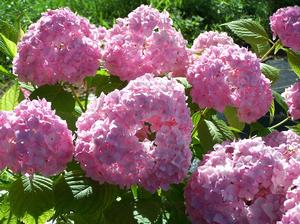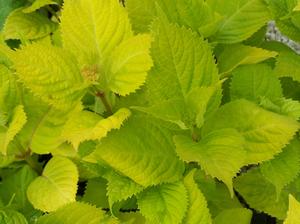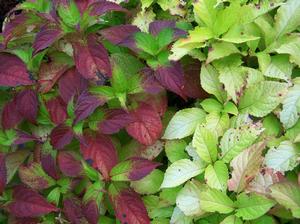
A lace cap form of Hydrangea macrophylla. This is 'Kardinal', not a remontant type - better planted nearer the coast from Provincetown south.

Hydrangea macrophylla 'Dooley', a mop head, is remontant and will bloom further inland.

The brilliant yellow foliage of Hydrangea macrophylla 'Rivendell'

The autumn leaves of 'Rivendell'
"Why Won't My Hydrangea Flower?"
Are you experiencing problems getting your mophead hydrangea to bloom? Does that beautiful lace cap hydrangea just produce green leaves and petulantly refuse to flower? Does your large-leaved hydrangea only set forth large leaves with maybe, possibly a bud or three every few years? Do you blame yours gardening skills? Well, don't! Chances are you simply have purchased the wrong plant for the right spot.
Hydrangea macrophylla, the Large-leaved Hydrangea comes in two flowering forms; one is the classic mop head, a large domed flower structure like those old-fashioned Hostess Snow Balls that usually came in pink but could be purchased in white... not unlike the hydrangea colors. The other flower form is the flattened lace cap with all sexual parts in the center surrounded with sterile florets which may very well act as attractants and landing pads for the pollinating insects.
Most Large-leaved Hydrangea, Hydrangea macrophylla, are genetically programmed to bloom on old or second-year wood. The shrub sends up new stems the first year. These soft, new stems must properly harden-off and become woody and seasoned as the temperatures cool in the autumn. If they do they will likely survive the winter. It is from these surviving stems, second-year wood or “old wood”, that the flowers emerge. The problem with our inland Connecticut climate is that the season usually ends too soon before the wood has properly hardened-off. The sugars in the stems do not have enough time to set-up.
Another issue and a possible double-whammy is that for some selections our winters may simply be too cold and the stems die to near the crown of the plant regardless of the sugar issue. This disables the plant from flowering though you may see a few flowers down near the base of the plant if the lowest parts of the stems were protected long enough by snow cover. In this case, unless we experience a mild autumn and a relatively warm winter with little or no extreme cold these shrubs may flower on the off year but probably not well in most. One can counteract this problem by planting in sheltered, warmer micro-climates close to the foundation of buildings – especially at a foundation on the other side of which is a heated basement. Another strategy is in late November to mid-December surround the shrub with 4 to 5 foot tall chicken wire or use 4 to 5 stakes set deeply into the ground and surround the stakes and attach burlap to them. Either way fill the fencing evenly all around the shrub with straw or oak leaves trying not to leave large air pockets but not so dense as to damage the shrub come heavy snow. Certainly some air circulating between your chosen mulch will be healthier for your prized hydrangea.
An easier alternative is to plant one or more of the “remontant” types. These are plants that bloom on both old and new wood. Some of the new stems which arise in a given year will produce some flowers. This is a great way to hedge your bets in northeastern Connecticut. Good old-fashioned 'Penny Mac', named for Penny MacHenry who happened to be the founder of the American Hydrangea Society, is a selection that has been available for a long time with just this trait. It appears that this very plant has re-incarnated in several named forms through the years. 'Penny Mac' grows 4 to 5 feet tall by 4 to 5 feet wide. Look for 'Penny Mac' to be certain you have purchased this good form. She is hardy from -20F, perhaps to -25.
Another remontant type is the very large-headed mop-head form, 'Dooley'. This one is relatively unknown and rarer in the trade. Interestingly, it was discovered in the backyard of coach Vince Dooley. 'Dooley', standing 5 feet tall and wide the enormous heads of pink or blue flowers based on soil Ph, will make you duly take notice! 'Dooley' is said to be hardy to zone 6 but has flowered well in zone 5b.
There is an increasing roster of remontant hydrangeas including the new dwarf Everlasting series growing only 2 to 3 feet tall available through Plants Nouveau. Members of this series include 'Amethyst', 'Jade', 'Garnet' and 'Revolution'. There is the Endless Summer series with traditionally taller forms. Endless Summer 'Blushing Bride', a pale pink to white form, has been a weak-stemmed and sloppy growing for us. We do not recommend you waste your money.
The Let's Dance series includes the first ever lace cap remontant hydrangea, Let's Dance 'Starlight'. There are more remontant type Large-leaved Hydrangea out there with new selections being bred and introduced. They are relatively easy to locate with an internet search.
We at Quackin' Grass have added to the more cold hardy hydrangeas that will actually bloom. We selected Hydrangea macrophylla 'Rivendell' from a tray of gold-leafed hydrangeas which came our way from Professor Jonathan Lehrer. The chosen seedling selection exhibited brilliant lemon yellow leaves in a nearly fluorescent hue. It was grown out, cuttings were made, more were grown out. Finally three of the established potted shrubs were planted in the garden. After a period of five years having been planted in fertile, moisture retaining ground in half shade this grouping has flowered annually regardless of the difficulty of the winter. And even more important than the flowering is that the old wood in most winters has survived with new growth emerging right up to the terminal tops of stems. We have not seen evidence that 'Rivendell' flowers on new wood, only that the old wood survives the winter and is alive and viable the following spring. 'Rivendell' exhibits greater stem hardiness than any other selection we've run across. Flowers are lace cap and smaller than other lace cap selections. It is, nevertheless, lovely - even beautiful. And never have we seen a cultivar with such stunning foliage. The flowers will turn deep, dark blue in spectacular contrast to the sunny yellow leaves if the soil is acidified. The foliage also develops a range of burnished autumn tones before finally dropping. The name 'Rivendell' was inspired by the legendary Elfin realm from The Lord of the Rings trilogy.
These popular shrubs are Ph sensitive. Add enough dolomitic limestone to the soil and flowers turn or will remain pink as this is the color that many selections will naturally exhibit. But if you want purplish to blue flowers acidify your soil using sulfur or ammonium sulfate. For best results add the amendments to your soil from near crown and extend its reach radially up to two feet away. This will provide most of the roots of the shrub which may reach out and away from the shrub's crown with your chosen amendment. Do it in the autumn so the amendment will have time to work before next years flowering. But before you do please consider the cultural requirements of neighboring plants. For example, a limed soil is a cultural anathema to acid-loving rhododendrons. A sweet soil for rhodies can cause damage and possibly death. Just be careful or your science experiment can result in disaster. Don't have a disaster. Rather, dig in. Have fun. And, for those at the northern end of the Hydrangea macrophylla range plant a remontant type... or maybe 'Rivendell'.
penned by Wayne Paquette, March 2015